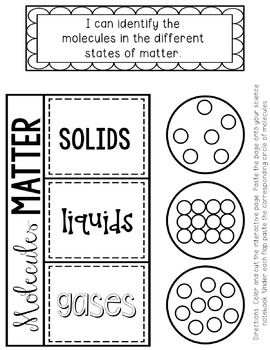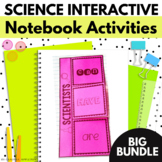States of Matter Science Interactive Notebook Activities - Templates
- PDF
What educators are saying
Also included in
- Do you want to reach a range of students' abilities and learning styles in your science class? These Science Interactive Notebook Activities are sure to engage your students in some fun interactive science lessons! This hands-on unit bundle is full of interactive activities that will keep your studePrice $21.60Original Price $27.00Save $5.40
Description
Do you want to reach a range of students' abilities and learning styles in your science class? These States of Matter Science Interactive Notebook activities are a sure way to engage your students in some fun interactive science lessons! This hands-on unit is full of interactive activities that will keep your students thinking and learning.
What is included in this product?
- Matter mini-poster.
- Solids, liquids, gases mini-posters
- Solids, liquids, gases poems
- Molecules under a microscope mini-poster
- What is Matter? Interactive Notebook Page
- 3 States of Matter (differentiated interactive notebook pages)
- I can describe solids, liquids, and gases
- Molecules in Matter (differentiated interactive notebook pages)
- Properties of Matter
- Properties of Objects
- Solids, Liquids, and Gases mini-books
- Changes in States of Matter
- Matter KWL chart
- Matter Vocabulary interactive notebook page
Your students will love learning all about the Properties of Matter with these interactive science activities!
Are you worried about prepping these activities? Don't be! These printables and interactive notebook templates are quick and easy to prep...Just print the student pages and you'll be ready for a fun and engaging class.
TEACHERS LIKE YOU SAID…
⭐️⭐️⭐️⭐️⭐️ Natasha T. said, "My students really enjoyed learning about the states of matter using these interactive notebook activities. Thank you for sharing!"
⭐️⭐️⭐️⭐️⭐️ Ruth D. said, "Made teaching science easy! "
⭐️⭐️⭐️⭐️⭐️ Judy G. said, "This provided a great resource beyond our text book. Thank you!"
____________________________________
Do you need other Science Interactive Notebook Activities? You'll love these:
Science Interactive Notebook Activities: What is Science?
Interactive Science Notebook: The Five Senses
Living and Nonliving Science Interactive Notebook Activities
____________________________________
Copyright © Gladys L. Appleton.
Permission to copy for single classroom use only.
Please purchase additional licenses if you intend to share this product.
Let's connect and be friends! Find me here:






